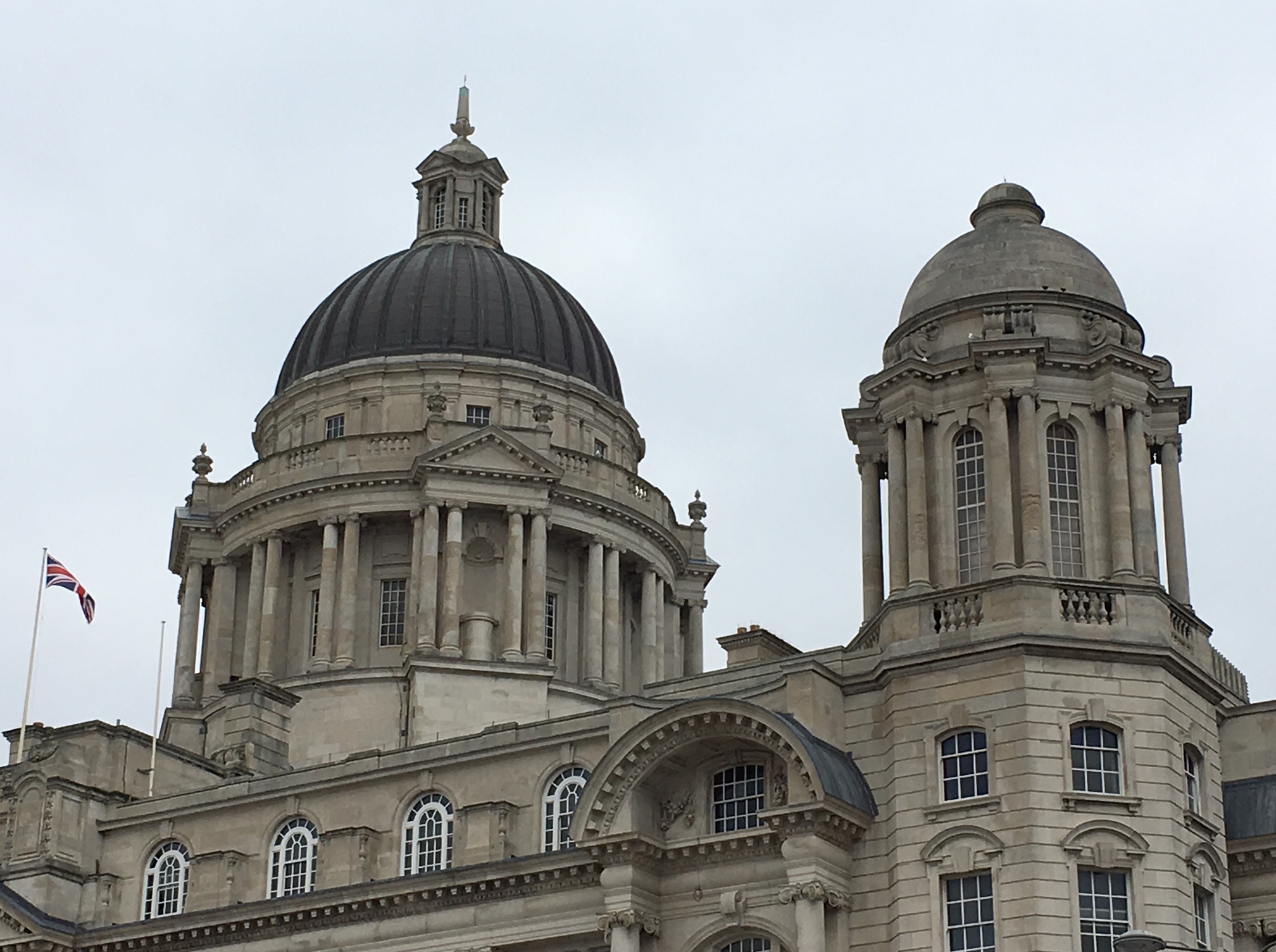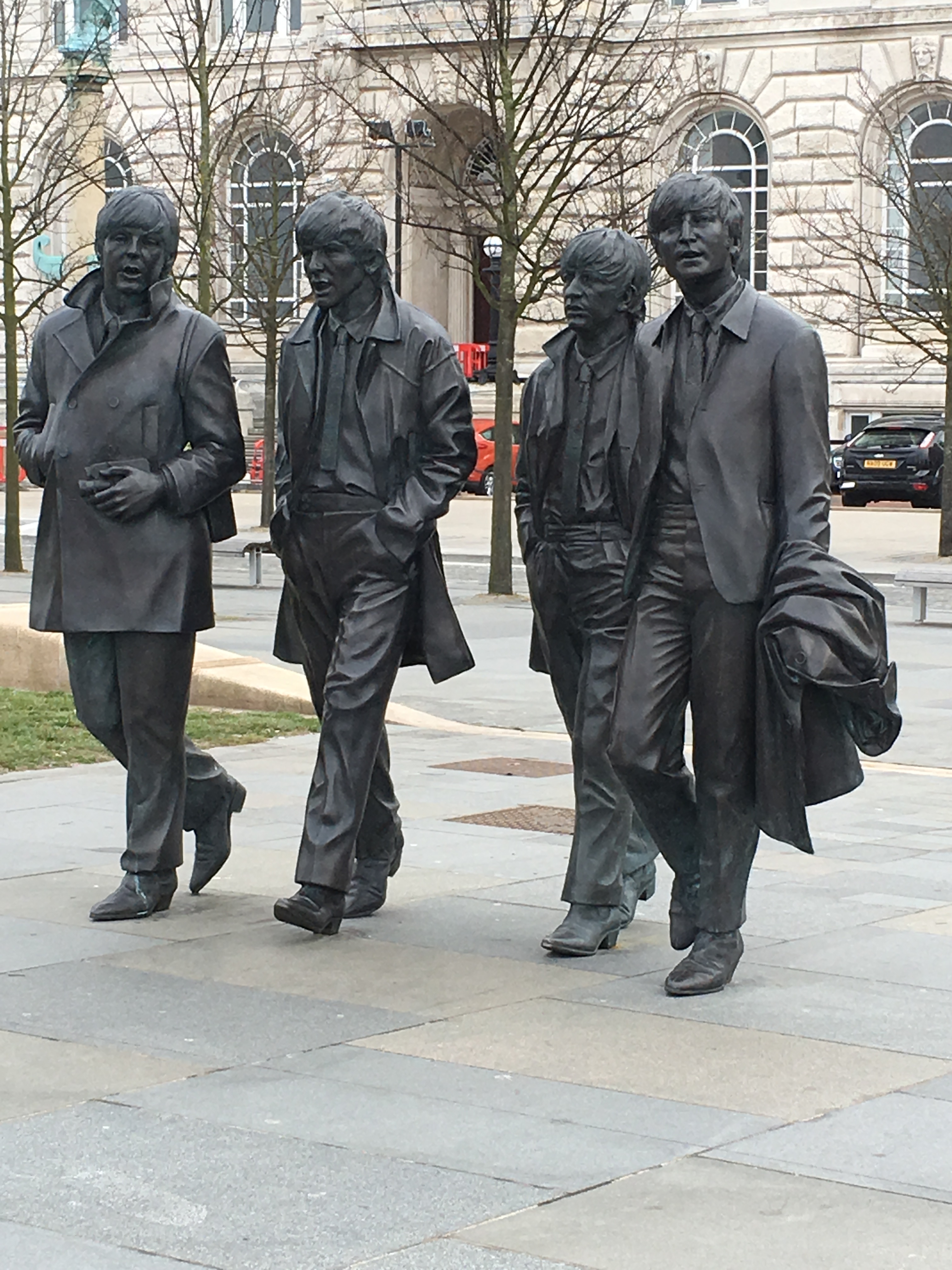Seaweed and barnacles cling tenaciously to the chest. The air is salty and damp. A tiny rivulet of water makes its way cautiously down a thigh. The wind launches a sand-filled gust at exposed arms and shoulders. The human form is unperturbed and gazes resolutely out to sea. It is one of an army occupying the beach. A benevolent presence. Silent, steadfast, watching…..
The beach that fringes the coast from Southport to Liverpool is broad, flat and featureless. It slopes very gradually into the Irish Sea. When the tide comes in it advances up the beach rapidly. You have to keep your wits about you when the tide turns. This daily rhythm of the sea moving up and down the beach created the ideal location for Antony Gormley’s statues when they were installed here more than ten years ago. Here on Crosby Beach Gormley positioned 100 cast iron statues, life size casts of his own body, distributed along the shoreline. The statues all face out to sea and many are submerged at high tide. The sculpture is called ‘Another Place’. When the tide moves up the beach the statues are submerged gradually, little by little, as waves march relentlessly to the high water mark. An isolated head and shoulders is all that remains of a lone statue now far out to sea.
These figures scattered across the beach are so evocative, so eloquent, in their silence. They witness the comings and goings of the Port of Liverpool and its hinterland. Sometimes when I go down to the front one of the statues will be wearing a school blazer and a cap or a football shirt. Over the last decade these forms have become embedded in the beach, they are an integral part of this coastline. ‘Another Place’ has become a landmark and a tourist destination[1]. It is fascinating to observe people interacting with the statues. You can see my daughter Lucy giving one of the statues a hug. My mother Mary was happy to make it out across the beach to say hello to one.
This part of the country and its relationship with the sea is deep rooted. The port of Liverpool developed as a maritime centre in the 17th century. Originally trade was between the west coast ports of Britain; Bristol, Liverpool and Glasgow and the ports of France, Spain and Portugal. Later there were trade routes across the Atlantic and to West Africa.The city grew and prospered. At one point it was the busiest port in Britain. Ships queued in the channel to enter the docks, warehouses lined the waterfront. Dockers waited on street corners for work. Liverpool was rebuilt in the early 19th century in a neo-classical style with St George’s Hall, a recreation of a Greek temple at its heart. The Pier Head was dominated by Customs House, The Cunard Building and The Liver Building. Ship owners and successful merchants grouped together and built themselves private clubs with libraries and news rooms enabling them to keep up with world events and to mingle with their peers. Examples of these clubs are ‘The Athenaeum’ and ‘The Lyceum’.
Foreign seamen arrived and made their home here. One of them a young man from Greece, an economic migrant, he’d be called today, was my great grandfather. He left his native Greece in search of work and opportunity. He eventually settled in Liverpool where he opened a fish and chip shop, married and had a son. The shop was in New Brighton, ‘across the water’ as the locals say. You had to get a ferry across the Mersey to New Brighton. This was long before Gerry and the Pacemakers sang the song.[2]It was a popular day trip on a Sunday afternoon. The fish and chip shop was successful. Five generations later my family still live in the north-west of England. In true entrepreneurial fashion we’ve been small business owners here ever since.
There’s a vibrancy about the city of Liverpool, there always has been. This is the city that gave us The Beatles[3], two football clubs and two cathedrals. Even in the dark days of the 1970s when the docks were empty and unemployment levels were high, the wit and sparkle of the average Liverpudlian shone through.


Growing up near the beach………..
Up the road to the north is the seaside town of Southport where I grew up, a stone’s throw from the beach. I had a recurring dream as a child that I would be on the beach early in the morning running down to the water’s edge. Then I’d look up and focus my gaze out across the waves and I could gradually make out the skyline of New York in the distance. If I concentrated really hard I could make out the distinctive art deco arches of the Chrysler Building and the monumental Empire State. On a clear day I was convinced I could reach out and touch the buildings. The distance from the Liverpool coast to New York is 3471 nautical miles. Even the most basic knowledge of trigonometry tells me that a person of average height standing at sea level can see just a few miles. If I was to stand at the top of a sand dune then the horizon might be as far away as 8 miles. I didn’t know any of these facts as an eight year old girl. Although I did know that the Atlantic Ocean separated England from the United States and that the Atlantic Ocean was very big indeed. However, night after night I saw that New York skyline from my local beach, and I was convinced that it was real. I like to think that Antony Gormley’s statues on the beach can see New York – that they too are marching out to sea.
After some initial objections the Gormley statues are now accepted on the beach at Crosby. In fact this is now their permanent home. Flush with the success of ‘Another Place’ the Liverpool Biennial,[4] Tate Liverpool and and 14-18 NOW decided to jointly fund another piece of art for the 2016 Biennial [5]. Sir Peter Blake was commissioned to design a colour scheme for one of the Mersey Ferries. Peter Blake is a famous ‘pop artist’ with a long association with Liverpool. He designed the cover for The Beatles Album Sergeant Pepper’s Lonely Hearts Club Band. The result of this imaginative commission is a spectacular and truly original Dazzle Ferry [6]. The Mersey Ferry ‘Snowdrop’ has been repainted in a dramatic and eye-catching style. Most weekends during the summer months you can see The Dazzle Ferry on the River Mersey ferrying passengers from the Pier Head to Birkenhead and Wallasey.
In the last five years Liverpool has continued to enjoy a renaissance. Visitor numbers are increasing. The Dazzle Ferry lights up the Mersey. If you haven’t been to Liverpool for a while then go! Visit the Pier Head, take a ‘ferry across the Mersey’, sample the Liverpool Gin distilled at The Belvedere Pub. Enjoy the bars and restaurants of Bold Street. Don’t forget to visit ‘Another Place’ at Crosby Beach and see what the impact of the statues is on you! Think about the regeneration of this coastal city and how art is being used to redefine this city and this coastline. Enjoy Liverpool!!
Footnotes:
- My friend Peter Goodbody wrote an interesting article about Gormley when he was being interviewed in July, 2015.Antony Gormley in Conversation
- Gerry and the Pacemakers were a 1960s pop band – part of the Mersey Beat. They famously sang ‘Ferry Cross the Mersey’ a Top Ten Hit in 1964.
- The Beatles did have to go and perform in Hamburg to get the break they needed.
- NOW 14-18 was a nationwide commemoration of the First World War. For more details go to The 1418 NOW web site.
- The Dazzle Ferry was painted using ‘dazzle camouflage’ a technique used in the First World War to confuse German U boats (submarines) and to help protect shipping.
- For more on growing up in Southport check out – Mrs Bech’s dresses………
- This article is now dedicated to Peter Goodbody who left these shores so suddenly in March 2023. Safe travels Peter…..we miss you.
Updated: May 2018 / June 2020 / Oct 2023


















This is fabulous Janet, a great read. Shared with all the family who will adore your observations and memories just as much as I do.
LikeLiked by 1 person
Thank you so much Jennie – I love writing about Liverpool and our Merseyside (West Lancs) upbringing!!
LikeLike
The Anthony Gormley figures have been on my “must do” list for a long time…
My nephew is about to move to LIverpool, so now I have a good excuse to visit that part of the world.
LikeLiked by 1 person
Juliet – you’d love the Gormley statues – visitors interact with them on the beach – it’s wonderful to observe and participate in….
LikeLike
We saw Gormley’s “Horizon Field” in Austria, probably 10+ years ago. It’s an amazing work, and the figures made me appreciate the sheer scale of the valley. But – it’s difficult to get up close to many of the statues there (at least for someone like me. whose hiking is slow, and rock-climbing skills non-existent!)
LikeLike
Such interesting stuff! I love the thought of you looking across to New York!
LikeLiked by 1 person
That takes me back – I can remember as a child being convinced I could see New York. The key was looking hard enough!
LikeLike
Thank you Mimi – glad you enjoyed it!
LikeLike
Liverpool–who knew it was more than the birthplace of the Beatles? Thanks for telling us the whole story, Janet–I can just imagine you gazing out across the ocean at the New York skyline. No wonder you grew up to be such a lover of travel and a small business owner yourself as you followed in the family footsteps!
LikeLike